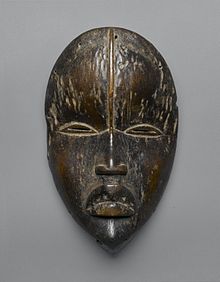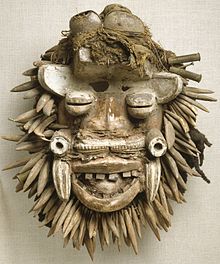Kami are the deities, divinities, spirits, mythological, spiritual, or natural phenomena that are venerated in the Shinto religion. They can be elements of the landscape, forces of nature, beings and the qualities that these beings express, and/or the spirits of venerated dead people. Many kami are considered the ancient ancestors of entire clans. Traditionally, great leaders like the Emperor could be or became kami.

Odinani, also known as Odinala, Omenala, Odinana, and Omenana, is the traditional cultural belief and practice of the Igbo people of south east Nigeria. These terms, as used here in the Igbo language, are synonymous with the traditional Igbo "religious system" which was not considered separate from the social norms of ancient or traditional Igbo societies. Theocratic in nature, spirituality played a huge role in their everyday lives. Although it has largely been synchronized with Catholicism, the indigenous belief system remains in strong effect among the rural, village and diaspora populations of the Igbo. Odinani can be found in Haitian Voodoo, Obeah, Santeria and even Candomblé. Odinani is a pantheistic and polytheistic faith, having a strong central deity at its head. All things spring from this deity. Although a pantheon of other gods and spirits, these being Ala, Amadiọha, Anyanwụ, Ekwensu, Ikenga, exists in the belief system, as it does in many other Traditional African religions, the lesser deities prevalent in Odinani serve as helpers or elements of Chukwu, the central deity.
Anthropology of religion is the study of religion in relation to other social institutions, and the comparison of religious beliefs and practices across cultures. The anthropology of religion, as a field, overlaps with but is distinct from the field of Religious Studies. The history of anthropology of religion is a history of striving to understand how other people view and navigate the world. This history involves deciding what religion is, what it does, and how it functions. Today, one of the main concerns of anthropologists of religion is defining religion, which is a theoretical undertaking in and of itself. Scholars such as Edward Tylor, Emile Durkheim, E.E. Evans Pritchard, Mary Douglas, Victor Turner, Clifford Geertz, and Talal Asad have all grappled with defining and characterizing religion anthropologically.

A mask is an object normally worn on the face, typically for protection, disguise, performance, or entertainment, and often employed for rituals and rites. Masks have been used since antiquity for both ceremonial and practical purposes, as well as in the performing arts and for entertainment. They are usually worn on the face, although they may also be positioned for effect elsewhere on the wearer's body.

Egungun, in the broadest sense is any Yoruba masquerade or masked, costumed figure. More specifically, it is a Yoruba masquerade for ancestor reverence, or the ancestors themselves as a collective force. Eégún is the reduced form of the word egúngún and has the same meaning. There is a misconception that Egun or Eegun is the singular form, or that it represents the ancestors while egúngún is the masquerade or the plural form. This misconception is common in the Americas by Orisa devotees that do not speak Yorùbá language as a vernacular. Egungun is a visible manifestation of the spirits of departed ancestors who periodically revisit the human community for remembrance, celebration, and blessings.

The Bassa people are a West African ethnic group primarily native to Liberia. The Bassa people are a subgroup of the larger Kru people of Liberia and Ivory Coast. They form a majority or a significant minority in Liberia's Grand Bassa, Rivercess, Margibi and Montserrado counties. In Liberia's capital of Monrovia, they are the largest ethnic group. With an overall population of about 1.05 million, they are the second largest ethnic group in Liberia (18%), after the Kpelle people (26%). Small Bassa communities are also found in Sierra Leone and Ivory Coast.

The Gẹlẹdẹ spectacle of the Yoruba is a public display by colorful masks which combines art and ritual dance to amuse, educate and inspire worship. Gelede celebrates “Mothers”, a group that includes female ancestors and deities as well as the elderly women of the community, and the power and spiritual capacity these women have in society. Focusing not only on fertility and motherhood but also on correct social behavior within the Yoruba society.
The diverse culture of Ivory Coast, a coastal West African country bordered by Ghana, Liberia, Mali, Burkina Faso, and Guinea, is exemplified by a multitude of ethnic groups, events, festivals, music, and art.

The Yaka are an African ethnic group found in southwestern Democratic Republic of the Congo, with Angola border to their west. They number about 300,000 and are related to the Suku people. They live in the forest and savanna region between the Kwango River and the Wamba River. They speak the Yaka language).

The Mumuye are people of the Taraba State, Nigeria. They speak the Mumuye language. They constitute the largest tribal group in Taraba State of Nigeria and form the predominant tribes found in Zing, Yorro, Jalingo, Ardo-Kola, Lau, Gassol, Bali and Gashaka, all of which are local government areas of the state. The Mumuye people are also found in many parts of the neighboring Adamawa State.
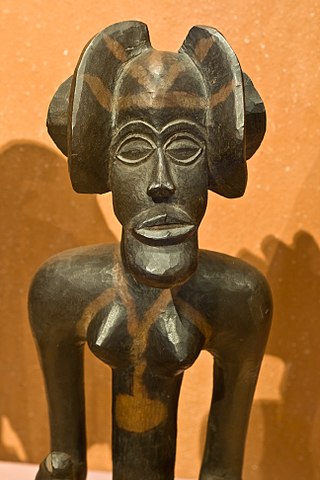
The Chokwe people, known by many other names, are a Bantu ethnic group of Central and Southern Africa. They are found primarily in Angola, southwestern parts of the Democratic Republic of the Congo, and northwestern parts of Zambia.

Mmanwu is a traditional masquerade of the Igbo people of Southeastern Nigeria. They are performed only by males in exclusive secret societies and involve the use of elaborate, colorful costumes that are meant to invoke ancestral spirits. Masquerade traditions have a varied range of purposes that span from performing elements of epic drama derived from community cosmology and lore, ushering in new months and seasons, honoring totems and ancestral spirits, enactments of parables or myths, with entertainment and community building serving as a consistent commonality. In the past masquerades also bore judicial, social regulatory, and even policing powers, however though these functions have decreased in modern times.
The Dan or Mano-Dan are a Mande ethnic group from northwestern Ivory Coast and neighbouring Liberia. There are approximately 700,000 members of the group and their largest settlement is Man, Ivory Coast. Neighboring peoples include the Krahn, Kpelle and Mano. They are officially known as Yacouba.

Igbo art is any piece of visual art originating from the Igbo people. The Igbo produce a wide variety of art including traditional figures, masks, artifacts and textiles, plus works in metals such as bronze. Artworks from the Igbo have been found from as early as 9th century with the bronze artifacts found at Igbo Ukwu. With processes of colonialism and the opening of Nigeria to Western influences, the vocabulary of fine art and art history came to interact with established traditions. Therefore, the term can also refer to contemporary works of art produced in response to global demands and interactions.
The Songye people, sometimes written Songe, are a Bantu ethnic group from the central Democratic Republic of the Congo. They speak the Songe language. They inhabit a vast territory between the Sankuru/Lulibash river in the west and the Lualaba River in the east. Many Songye villages can be found in present-day East Kasai province, parts of Katanga and Kivu Province. The people of Songye are divided into thirty-four conglomerate societies; each society is led by a single chief with a Judiciary Council of elders and nobles (bilolo). Smaller kingdoms east of the Lomami River refer to themselves as Songye, other kingdoms in the west, refer to themselves as Kalebwe, Eki, Ilande, Bala, Chofwe, Sanga and Tempa. As a society, the people of Songye are mainly known as a farming community; they do, however, take part in hunting and trading with other neighboring communities.

The Sandobele are members of the Sandogo, an authoritative women's society of the Senufo people, who practice divination. The Senufo inhabit the savannas and tropical rain forests of northern Côte d'Ivoire and the nearby land in Mali and Burkina Faso. The Sandogo is responsible for sustaining positive relationships with the spirit world through divination and for protecting the purity of each kinship group. The word Sandobele originates from the Senufo language.
The Kwele people, or Bakwele, are a tribal group of eastern Gabon, Republic of the Congo, and Cameroons in Central Africa. In terms of their language, they fall into the Bantu linguistic group. Their population consists of approximately 120,000 individuals. They fled the coastal area of West Africa during the 19th century after their traditional enemies acquired firearms from the slave traders. This altercation is often called the "Poupou" war. The Kwele then settled into lands between the Dja and Ivindo rivers. Their assumed five separate linguistic subgroups are identified by differences in where their community lies on a map, where they have migrated over time, political structure, performances implemented in rituals, and the community cohesion within each. When conflicts arise, their strategies to resolve these issues may be handled by intense individual competition. Important relations are impacted by the father's line of descent, due to past patrilineal and avuncular political decisions and relations.

Public masquerades play an extremely significant role in the life of the Mende people - one of the two largest ethnic groups in Sierra Leone.
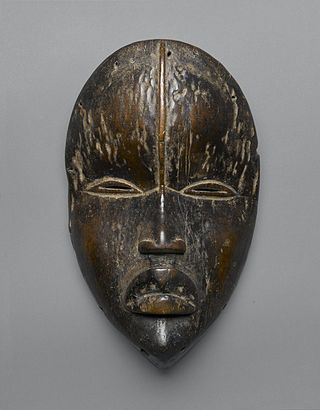
Dan art is created by the Dan people of Liberia and the Ivory Coast.
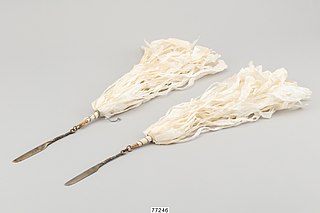
The mengdu, also called the three mengdu and the three mengdu of the sun and moon, are a set of three kinds of brass ritual devices—a pair of knives, a bell, and divination implements—which are the symbols of shamanic priesthood in the Korean shamanism of southern Jeju Island. Although similar ritual devices are found in mainland Korea, the religious reverence accorded to the mengdu is unique to Jeju.
